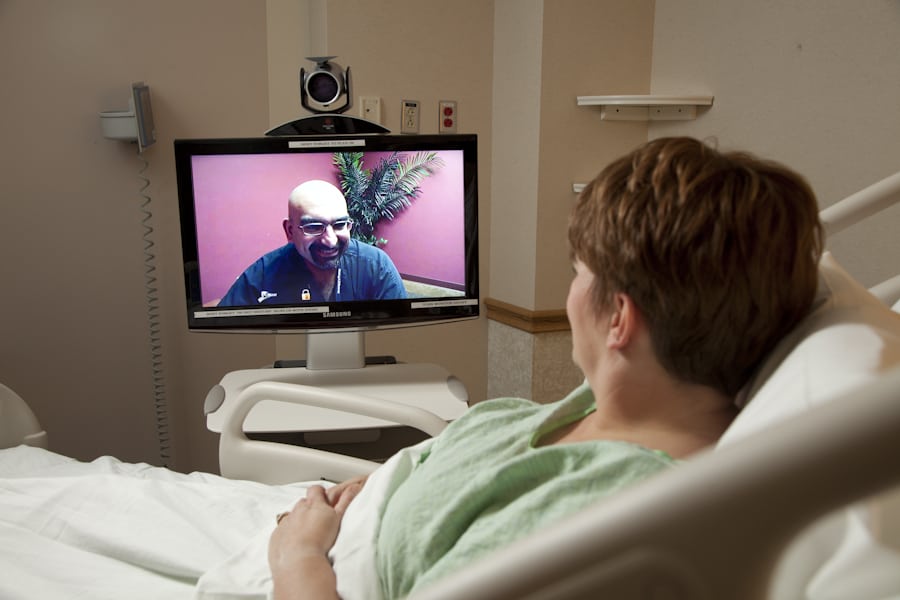How Technology Is Improving Mental Healthcare
Technical Blog Post 8
One in four American adults experience a mental illness or substance abuse disorder every year, yet over 60% do not undergo treatment. Technology is providing extraordinary new solutions to this problem. In fact, the fascinating role that technology is playing in revolutionizing mental healthcare is what inspired me to study software engineering. This post will address how telepsychiatry, virtual reality and video games, and social robotics are improving mental healthcare.
Telepsychiatry:
 A patient sees a doctor via telemedicine. Image by Richard Muldez, Albemarle Hospital.
A patient sees a doctor via telemedicine. Image by Richard Muldez, Albemarle Hospital.
Telepsychiatry involves connecting patients with psychiatrists through technology. Companies like 1docway and Insight Telepsychiatry offer features like video-conferencing, electronic medical records, and e-prescribing so that the 89.3 million Americans living in Mental Health Professional Shortage Areas can receive treatment. The Department of Veterans Affairs is the largest provider of telepsychiatry. They have conducted over one million teleconsultations.
Virtual visits have been found to be clinically equivalent to in-person sessions. The Department of Veterans Affairs saw a 25% decrease in hospital admission rates and length of stay because of telepsychiatry usage. Moreover, patients often prefer teleconsults since they feel more comfortable disclosing their feelings through technology.
Many insurance companies reimburse telepsychiatry since they appreciate its cost-savings potential. Medicare reimburses for telepsychiatry in all states and Medicaid reimburses for telepsychiatry in 45 states. Some states even offer rural clinics a bonus fee for using telepsychiatry. Approximately 19 states require private insurers to reimburse telepsychiatry and many more have pending legislation for mandating private insurance coverage.
One of the great challenges telepsychiatry faces is the lack of standardization of licensure regulations across states. The majority of states prohibit doctors who are not licensed there from providing care from across state borders. Groups like the American Telemedicine Association are advocating for legislation that would mandate standardization, so there may be more uniformity in the near future. Despite barriers such as the lack of nation-wide insurance parity or licensure regulations, the ever-increasing use of telepsychiatry has opened up a whole new world of care for patients who otherwise would have had to travel extensive distances to see a doctor.
Virtual Reality and Video Games:

A soldier receives treatment for PTSD via virtual reality. Image from the US Air Force.
Virtual reality is providing another avenue for enhancing mental healthcare. Inworld Solutions (a sister company to Insight Telepsychiatry) offers avatar-based therapy solutions that replicate a support group environment. The Virtual Reality Medical Center and Institute for Creative Technologies in California use simulation technologies to treat patients with anxiety disorders and to train mental healthcare professionals.
The US Department of Defense has invested over $135 million in the Instiute for Creative Technologies’ virtual reality programs. Virtual reality resilience training is being used to prepare soldiers for combat. For those who have already experienced trauma, Virtual Reality Exposure Therapy attempts to decondition emotional responses through a graded and repeated imaginary reliving of the traumatic event. Another interesting application of virtual reality is SimCoach, which allows veterans to seek health care advice by interacting with a virtual human health care guide.
Oculus VR, a virtual reality company that Facebook recently acquired, is also partnering with the Institute for Creative Technologies to explore ways to make virtual reality mental health technologies more widely available.
Video games that improve mental healthcare are being developed as well. One game that is worth noting is Sparx, which incorporates Cognitive-Behavioral therapy principles into an interactive fantasy game to reduce depression and anxiety in adolescents. Research done at the University of Auckland, where the game was developed, has found it to be clinically effective. This can help teenagers who either are uncomfortable asking for help in-person, have limited access to doctors, or who cannot afford treatment costs.
Social Robotics:
 Paro the therapeutic seal. Image from Jacobs-University
Paro the therapeutic seal. Image from Jacobs-University
Social robots are another exciting example of how technology is being used in a therapeutic context. For example, a robotic seal named Paro is being used to provide animal therapy without needing live animals. At $6,000, Paro is currently too expensive for mass purchase but he has had a positive impact on those who have interacted with him. Paro has been found to reduce stress and increase interaction between Alzheimer’s patients and their caregivers.
Social robots are also being used to help children with autism and other developmental disabilities. Eli Kim, Brian Scassellati and other researchers at the Yale Social Robotics Laboratory are exploring how a robotic dinosaur named Pleo can be used to teach proper speech prosody and social skills to children with autism.
Another significant use of social robotics involves helping bullying and abuse victims. Research led by Cindy Bethel at Mississippi State University is investigating whether children are more likely to answer questions about their experiences being bullied to a robotic interviewer versus human interviewer or paper survey.
It will be exhilarating to observe how many lives will continue to be transformed by technology.